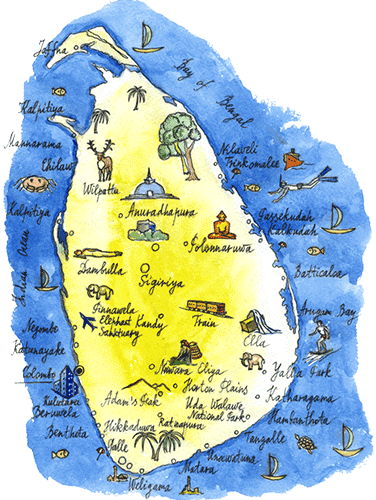
Sri Lanka is an enchanting tropical island and there has never been a better time to surrender to its charms. Explore stunning beaches, awe-inspiring hill country, wildlife parks, ancient cities and venerated temples. Revel in our great range of activities, wonderful food and a choice of accommodation that rivals anywhere in the world. Discover yourself in the island with a little bit of everything.
Yamu Travels can offer great discount deals for 2020 to enable you to discover an island bursting with joy at highly-competitive prices. Opt for a tailor-made itinerary , choose one of our specialist tours or just browse our list of the tour packages the island can offer. Whatever your budget, our Sri Lanka holidays offer unbeatable value.
We have caringly designed holidays in Sri Lanka since the company was formed in Italy nearly 10 years ago. This tropical island, found off the southern tip of India, is called the ‘Pearl of the Indian Ocean’. We fall in love daily with its sights and sounds and the warmth of the people.
VISA INFORMATION
TRANSIT AND VISITOR VISA
Transit visas good for 48 hours are free. Thirty-day visitor visas cost US$25 to US$100, depending on your nationality. Apply in advance online (www.eta.gov.lk).
OBTAINING A VISA
Before visiting Sri Lanka, do the following to get a 30-day visa:
ONLINE
– Visit the Sri Lanka electronic visa website (www.eta.gov.lk) several days before arriving.
– Follow the online application process and pay with a credit or debit card.
– Once approved, print out the visa confirmation.
EMBASSIES
– You can also obtain visas at Sri Lankan embassies abroad and there is a counter at Bandaranaike International Airport for people who arrive without a visa, although you’ll have to wait with the other visa-less masses (which can take several hours) and pay a higher fee: US$40
VISA EXTENSIONS
– You can renew a 30-day tourist visa twice, for 30 days each time. Contact the Department of Immigration and Emigration. Extensions are not hard to get but require jumping through some bureaucratic hoops and downloading some forms. To complete the process in one day, arrive to the office by 10am and expect it to take at least four hours.
TRAVEL INSURANCE
Unless you are definitely sure that your health coverage at home will cover you in Sri Lanka, you should take out travel insurance – bring a copy of the policy as evidence that you’re covered. Although medical expenses in Sri Lanka are relatively low to that of other countries, it is always advisable to be covered when travelling abroad so you’re ready for anything such as
– Flight cancellations
– Emergency medical transportation
– Emergency medical expenses
– Lost or stolen valuables
HEALTH AND SAFETY
While the potential dangers of Sri Lankan travel may seem worrisome, most travellers experience nothing more serious than an upset stomach. Travellers tend to worry about contracting infectious diseases, but infections rarely cause serious illness in healthy travellers.
Click here to read what the lonely planet recommends on health and safety.
CLIMATE
Low Season (May–Aug) The Yala monsoon season (May to August) brings rain to the south and west coasts plus the Hill Country. The weather in the North and East is best. Prices nationwide are lowest.
Shoulder (Apr & Sep–Nov) April and September offer the best odds for good weather countrywide. New Year’s celebrations in mid-April cause transport to fill beyond capacity. A good time to wander without a set schedule.
>High Season (Dec–Mar) The Hill Country plus west- and south-coast beaches are busiest – and driest. With beds in demand, prices peak. The Maha monsoon season (October to January) keeps the East, North and ancient cities wet.
GEOGRAPHY
Completely surrounded by ocean, Sri Lanka is an island located south of India occupying an area of 65 610 square kilometres. Its highest point is the Pidurutalagala Mountain at 8,281 ft. In terms of demographics, Sri Lanka’s population stands on the verge of 21 million with Colombo being the most populated city and Sri Jayawardenapura being the capital of Sri Lanka.
GOOD TO KNOW
Sri Lanka is an easy place to navigate if you remember a few key points.
Temple footwear: Remove shoes and hats at temples. Socks are OK for walking scorching pavements.
Clothing: Cover shoulders, arms and legs at temples as directed.
Buddha statues: Never pose beside or in front of a statue (i.e. with your back to it), as this is considered disrespectful.
Buddha images: Displaying body art or wearing clothing that includes an image of the Buddha can get you arrested and deported.
Photography: Ask permission before photographing people. A few business-oriented folk like the stilt fishermen at Koggala will ask for payment.
Beach attire: Nude and topless sunbathing are not allowed on beaches.
Modesty: Overt displays of affection in public places are frowned upon.
Avoid left hands: These are considered unclean. Use both hands or just your right.
WHAT TO BRING
-A good pair of earplugs.
-Effective mosquito repellent – hard to find in Sri Lanka (unlike mosquitoes).
-Sunscreen – another surprisingly hard-to-find item.
-Tampons – nearly impossible to find outside Colombo.
-Extra phone-charging cables – difficult to find in remote areas.
-Pro tip: Shorts and a T-shirt will work most of the time, but bathing suits and bikinis are never proper off tourist beaches. Bring a cover-up for shoulders and arms, and a long skirt, sarong or light pants for visiting temples. Sandals are always fine and are good for slipping off quickly when visiting temples. Something slightly dressy is required only for the very best restaurants in Colombo. For the elements, a super-lightweight waterproof jacket or poncho is useful in case of sudden downpours, and a warm layer if spending time high up in the temperate mountains.
